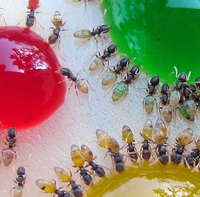Color-Soaked Bugs: Color Sense in Insects

Dr. Mohamed Babu, India, turned thirsty garden ants into a cool series of photos and an interesting hands-on look at color sense and insects.
You've heard of being caught red-handed? The brightly colored abdomens of the bugs in a series of photos taken by Dr. Mohamed Babu (Mysore, India) leave little doubt as to which colors of sugared water the translucent-bellied ants in his garden had been sipping. Reportedly, his wife noticed that the ants turned white when they sucked up some spilled milk, which gave him the idea for this colorful garden science experiment—and photo opportunity.
The images of the 'technicolor' ants are striking, but there's plenty of room here for further student exploration! The photos Dr. Babu took, and his observations as to which colors the ants clearly preferred, leave a colorful trail for student research into color-preference among animals and insects.
Color Sense: Aesthetics or Survival?
In the wild, 'color' provides a lot of information. Some colors are perceived to indicate something safe. Other colors signal danger or poison. Some species, in fact, have certain colorful exteriors that warn others away: don't eat that brightly colored frog, it is poisonous! And when a blue-tongued skink sticks out its tongue, predators perceive "danger" and run away! (Keep in mind that most animals and insects don't see color the same way humans do, but they still process "color" information.)
Making Connections
Students intrigued by the way the ants' bodies visibly soaked up the color in Dr. Babu's photos, might experiment with local ants to see if they have similarly translucent body parts. (Or try a variety of "clear" mite.) Or, as part of a controlled exploration, students might replicate the process Dr. Babu used to see if local ants demonstrate similar color preference. His ants, for example, notably preferred two of the four colors of sugared water he made available.
Other science projects that could be explored for a color-sense science project include:
- Do Milkweed Bugs Show a Color Preference for Egg-Laying Sites?: The brightly colored exterior of a milkweed bug may warn predators that it "tastes" bad because of the toxic sap it slurps from milkweed plants. In this project, students explore whether or not the color of the milkweed plant matters to the bugs when they select a site for egg-laying.
- How Sweet It Is! Explore the Roles of Color and Sugar Content in Hummingbirds' Food Preferences: If you feed hummingbirds, or know someone who does, you probably know that there is a specific color commonly used for kitchen-brewed, sugary hummingbird food. Is the color alone enough to make a hummingbird choose one solution over another? In this project, students ask, "what is more important... the color of the solution or the amount of sugar it contains?"
- Perfect Plating: Which Food Presentation Technique is Best?*: Humans, too, evaluate food based on color. We know, for example, that plates of food that contain green or orange are likely to be more nutrient-packed than plates of food that are all white. But even beyond our knowledge of vitamins, we may "respond" to foods based on color. This cooking and food science project encourages exploration of how "presentation" affects response to food. While this project looks at what might be considered "serious" cooking, if you are around small children, you might ask... does changing the color of the food change the chance that they'll eat it?
A 'Closer' Look
If colored ants don't give you the creepy crawlies, you might enjoy seeing this wonderful series of seriously zoomed-in insect photos by Stephen Gschmeissner!
Categories:
You Might Also Enjoy These Related Posts:
- 15 STEM Gifts & Science Kits You'll Feel Good About Giving
- 13 Boat Science and Submarine Science Projects and Experiments
- July 4th STEM! Summer Science Picks for Independence Day!
- 12 Science Kits for Summer Science Experiments and Discovery
- 15 Science Projects to Make and Give for Father's Day
- Ready, Set, Go! (Awesome Summer Science Experiments)
- Awesome Summer Science Experiments
- 10 STEM Activities with Cardboard Tubes









